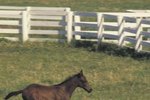
Ground training a miniature horse is like training a full-sized horse. However, just because they come in a small package does not mean you can slack on the groundwork. The same techniques used on larger horses offer the same benefits, and help you gain trust and control from your mini.
Longeing
Longeing your mini requires a well-fitting halter and a 30- or 40-foot longe line. After fitting your mini horse with a halter, attach the longe line to the bottom ring of the halter under your horse’s chin. Have him move to the left by giving him some slack on the line, directing him by pulling left on the line, and raising your right hand. Wave right hand up and down or even smack your hip and make a noise to get him moving. Switch hands with the longe line and raise the opposite hand to get him to move to the right.
Round Pen
The round pen is a tool that all horse trainers and owners should have. Have your horse move away from you, like on the longe line by turning your shoulders slightly in the direction in which you want the horse to move and waving your hand. Use a command, such as a smooching noise, and create a cue your mini relates with moving forward. Keep her moving then ask her to turn by stepping in front of her with your shoulder facing the opposite direction and waving your opposite hand. This teaches her to change directions while moving. Ask her to stop by stepping in front of her and saying “whoa” sternly. If she turns and keeps moving, step over in the opposite direction and repeat your command until she stops.
Ground Work
After your mini horse understands moving and turning, teach her to turn and stop from the ground before riding or hooking her to a cart. Fit her with a bridle and smooth-snaffle bit. Attach the reins to the rings on each side of the snaffle bit. While holding both reins in one hand, have her walk forward, then ask her to stop by applying even, backward pressure to the reins, just like you would if you were riding. Detach one of the reins and teach her to give her nose and respond to direct rein pressure. Stand on the side on which you want her to turn and pull her nose toward you. As soon as she responds by “giving” her nose, release the pressure. Do this on each side until she gives to the slightest amount of pressure.
Tips
Always stand far enough away from your mini that you are out of kicking range. For stubborn horses, consider using a whip to get him moving. Do not pop the horse with the whip; simply hit the ground with it behind where he is standing. The noise often is enough to motivate him. The snaffle bit should sit right behind your horse’s back teeth and not slide down onto his tongue. Spend quality time daily brushing your mini and bonding with her. This helps build trust and a partnership.
References
Resources
Photo Credits
-
Thinkstock/Comstock/Getty Images
Writer Bio
Amanda Maddox began writing professionally in 2007. Her work appears on various websites focusing on topics about medical billing, coding, real estate, insurance, accounting and business. Maddox has her insurance and real estate licenses and holds an Associate of Applied Science in accounting and business administration from Wallace State Community College.




